Pontiac Cams - Shake or Roll?
By: Jim Hand
Written for the 1997 Pontiac Southern Nationals
This section is a recreation of the technical seminar that Jim Hand presented to Pontiac enthusiasts at the 1997 Pontiac Southern Nationals in Dallas Texas. There is a lot of technical data presented below, so please take your time in reading. Jim Hand has become a regular at the Pontiac Southern Nationals, as well as Pontiac fans across the country, greatly respect and admire him for the knowledge he has and is willing to share with us.
Pontiac Cams - Shake or Roll?
What kind of title is that? It is very easy to make a Pontiac shake - Misadjust the carb - Screw up the timing - Install very cold spark plugs - or install a radical cam. However, to make a street Pontiac really roll requires some knowledge and experience in cam selection. That is what we are going to cover today. Some things to consider when selecting a cam for best street and strip performance. The definitions and discussions about cams will also apply to race cams. Some technical aspects of cam design will be discussed, but primarily, we will talk about the effects of various cam parameters on engine performance.
We will begin with a short video of two vehicles. The first vehicle is a '75 Grand Ville convertible that the owner has had customized. He picked the paint colors! The second vehicle is my '71 LeMans wagon.
Video was Shown at this point of seminar
My son Joe did all under hood work (except pick the paint colors), and installed the Ford 3.50 rear axle and one piece driveshaft. Joe and I built the 469 engine and installed it and the aluminum radiator. The second vehicle is my '71 LeMans wagon. The engines are very similar with identical cams, RPM manifolds, and 750 Q-Jets. Both run on 92 octane pump gas, and both idle well at 650-700 in Drive with about 14" vacuum. The Grand Ville weighs 4800+ with driver, fully operational AC, PB, and PS, and was run with all belts tight and air filter element installed. The wagon weighs 4100# with driver. The Grand Ville is an excellent example of what we mean when referring to a streetable car with excellent throttle response and smooth idle with great performance. The wagon is more oriented towards strip work, but also is very easy to drive with smooth idle. During our discussion today, a reference to idle means engine RPM in the 500 to 800 range. When we talk about low end power, we mean power in the range of 1500 to 3000. Mid range is 2500 to 4000, and top end means 4000 and up.
1. We will start with a quick look ( SLIDE #1 below ) at a computer prediction of relative performance of two cams. The computer program is "Engine Analyzer" from Performance Trends. The base engine is my 462 9.8cr unit with mildly ported '71 #96 heads. The two cams are:
A Pontiac 744
with 1.65 rockers. It has 224 degrees intake and 236 degrees exhaust duration
at .050 tappet lift. With the 1.65 rockers, it has about .450 lift.
The second cam
is a Crane 3/4 Race unit with 226 degrees intake and 236 degrees exhaust
at .050 tappet lift. It has about .469 lift.
Although these
two cams are very similar in duration and lift, the predicted performance
is vastly different. What is causing such a variance in performance? Please
remember that the computer generated torque and HP numbers are a prediction,
and not actual numbers. I will be using several computer generated predictions
to review the effects of cam parameters. Do not get hung up with any
computer predictions, regardless of the program type. These programs are
developed using the most common engines, and Pontiacs are not one of the
most common units. Computer programs can indicate trends in performance,
and that is how they should be used. This particular program recognizes
air flow only at .525 valve lift for the 2.11 valve, so it is more oriented
towards peak HP. It does predict the peak power of my 462 reasonably
close, based on drag strip performance of my wagon. We will discuss this
plot in more detail later, but first, let's talk about basic engine operation
and cam parameters.

Basic Operation:
This slide illustrates the four cycles of a normal engine.
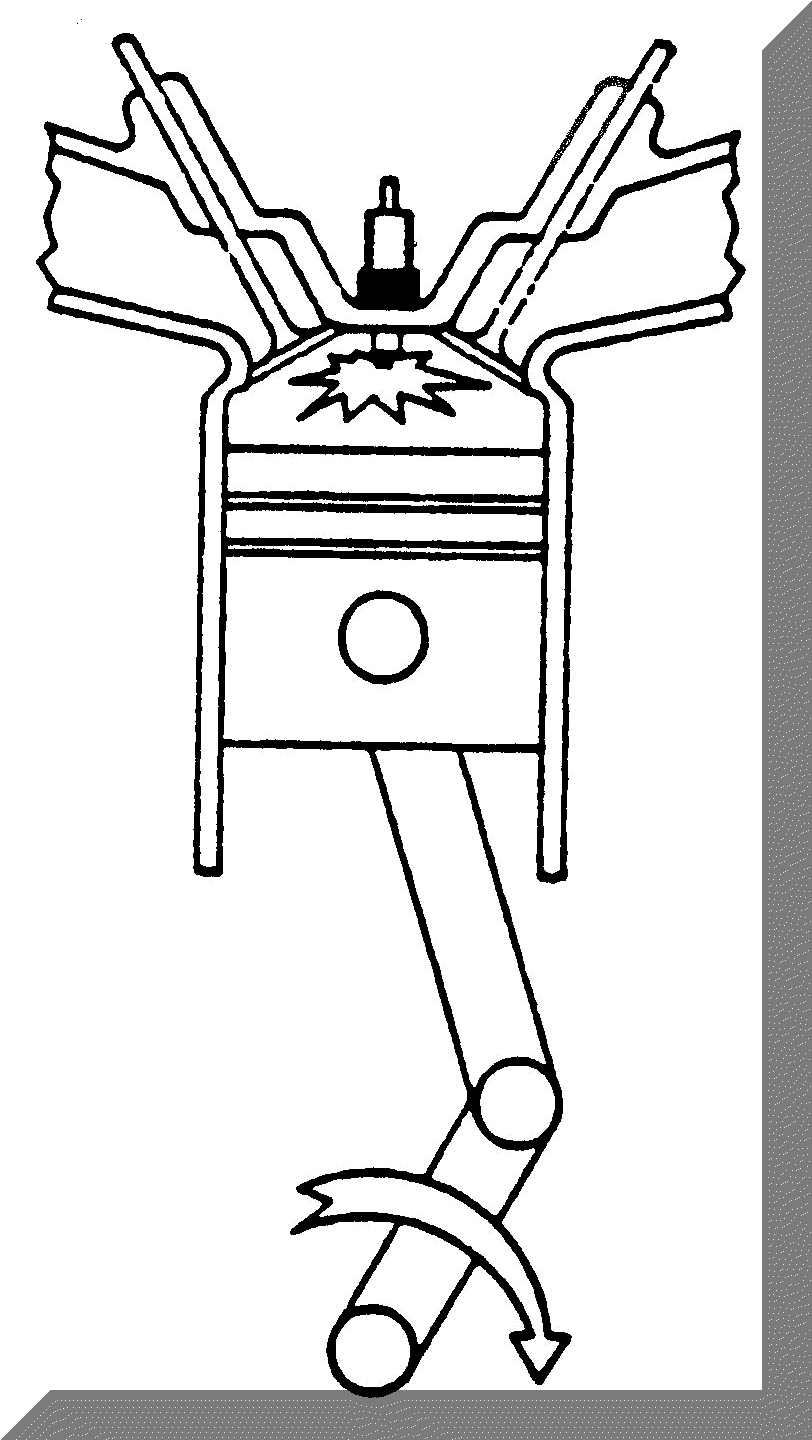
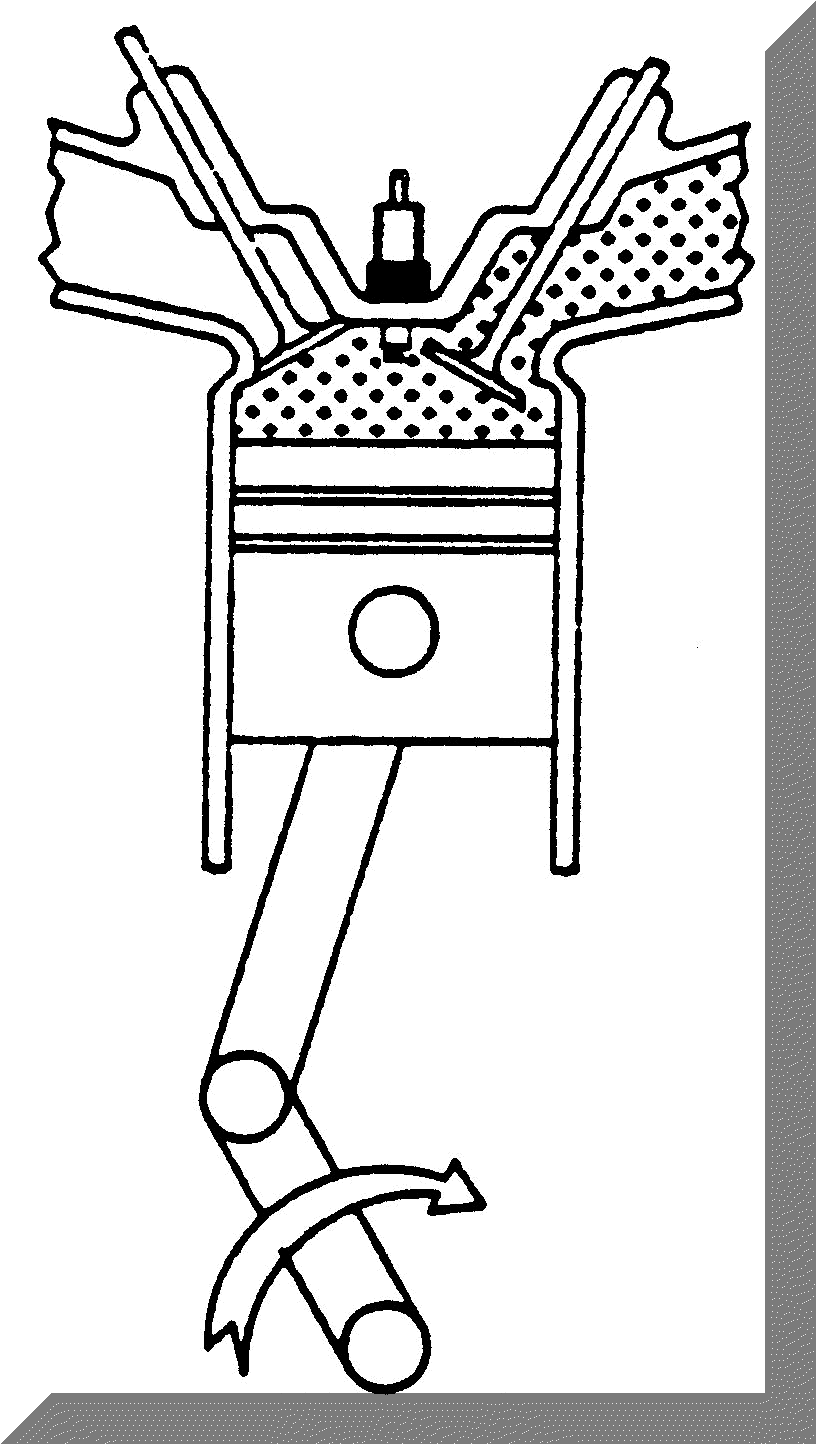
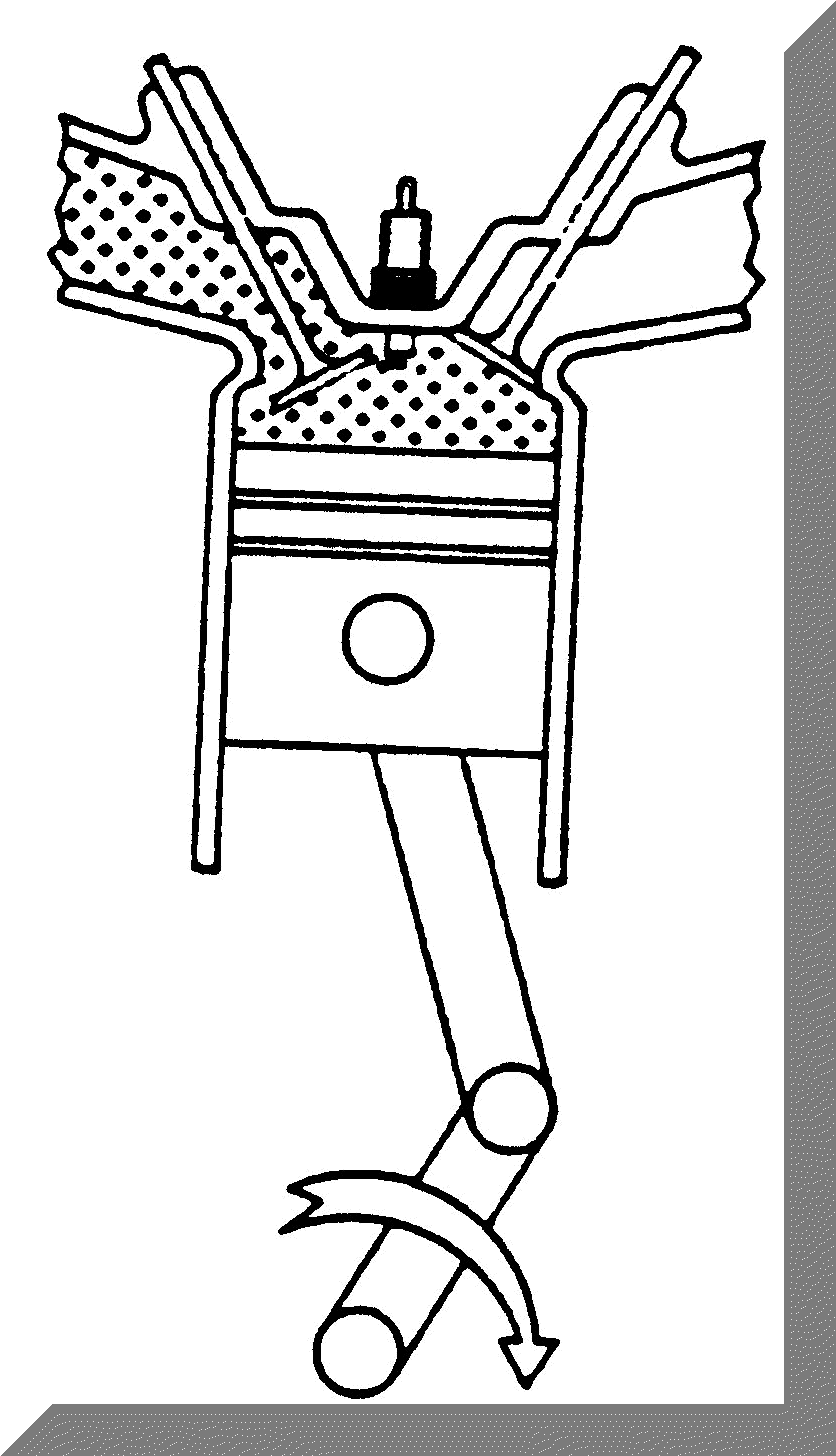
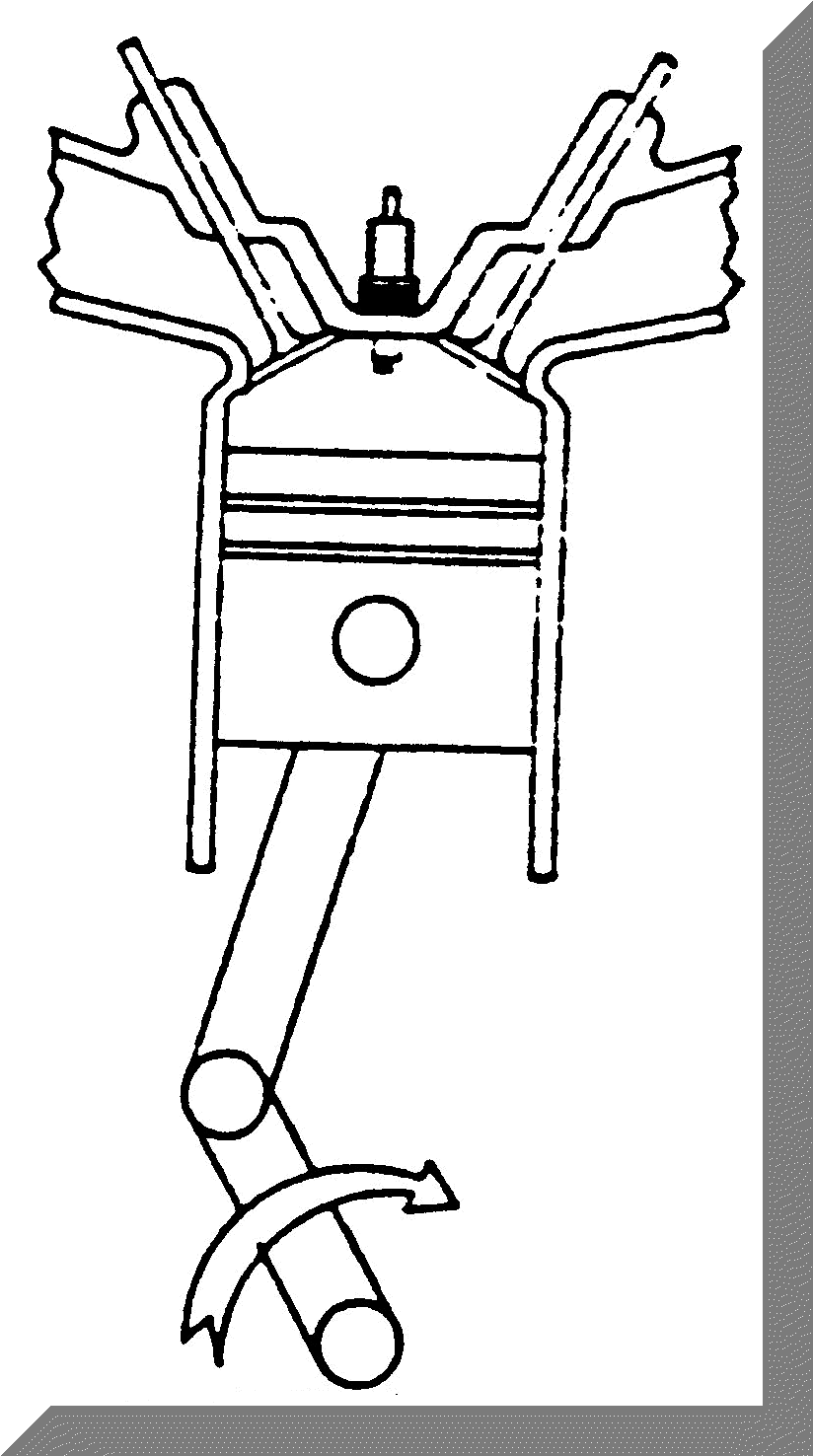
| 1
Power Stroke |
2
Exhaust Stroke |
3
Intake Stroke |
4
Compression Stroke |
SLIDE #3

This slide above shows a typical exhaust and intake valve cycle for one cylinder cycle.
Duration; The
length of time in crank degrees the valve is off the seat.
Advertised duration:
Who knows? Measured at .004 tappet lift, .006, .009? Unable to compare
one cam to another.
Duration at .050
tappet lift. An industry standard that allows direct duration comparison
from one cam to another. The lobe design may be slightly different and
provide a steeper opening and/or closing curve, but using .050 tappet lift
to compare duration is the best method.
Lobe Lift; The
actual lift caused by the cam lobe from the base circle to the lobe center.
Valve lift; The
lobe lift multiplied by the rocker arm ratio.
The valve lift
generally controls peak torque. It will also affect the RPM range if extremely
high or low. Our street engines will respond well to a valve lift up to
about .480. More does not hurt engine output, but doesn't seem to help.
Rocker arm ratio has an impact on lift as well as duration. Within a given duration, peak lift is limited due to the required dynamics of the lifter, lobe, springs, and valves. The lifter must be accelerated as rapidly as possible, yet slowed enough to follow the lobe nose and closing side ramp. A high lift lobe with aggressive lift and closing ramps can be very hard on valve train reliability. That is why Pontiac used 1.65 ratio rockers with the 041 rather than redesigning the cam. More lift and quicker lift rate can be obtained with the same lobe profile, lifters, and similar pressure valve springs.
Lobe Centerlines.
The lobe centerline is that point in reference to the crankshaft that the lobe reaches maximum lift. Note that the intake centerline will always be after TDC, and the exhaust centerline will always be before TDC.
Cam Centerline or Lobe Separation Angle
If we advance the cam 4 crankshaft degrees, the
intake centerline moves from 106 to 102 and the exhaust centerline moves
from 114 to 118. However, the distance between the two lobes does not change.
That distance between the two lobes is known by either of two names: The
cam centerline, or as we prefer, the lobe separation angle. When we
reposition the cam by advance or retard, the lobes advance or retard, but
the separation angle remains the same. To determine the separation angle,
add the crankshaft degrees positions of the two lobes and divide by two.
The result is separation angle in camshaft degrees. This is the
only cam parameter that is stated in cam degrees. The separation angle
is ground into the cam and cannot be changed. The lobe positions determine
the cam advance or retard as ground. For example, to determine the advance/retard
of this cam, we subtract the intake CL from the exhaust CL and divide by
two. Advance/Retard is a reference to the positions of the intake and exhaust
valves in reference to TDC. This cam is ground 4 degrees advance. If we
advance the cam 4 degrees, we now have a total of 8 degrees advance in
reference to TDC. What would be the advance/retard of a Pontiac 041 cam
with the intake at 112 and the exhaust at 115? (1.5 A) How about a Pontiac
066 with 107 intake and 116 exhaust? (4.5 A). What would be the lobe separation
of an 066? (112.5) The lobe centerlines and the lobe separation are extremely
important as we will show later, and you should become familiar with cam
specs and how to determine both of these parameters.
Timing Events:
Exhaust Opening.
The exhaust valve is opened a considerable time before the end of the power stroke. Much of the exhaust leaves the chamber early in the cycle during the initial "Blow Down". Very little exhaust is moved during the last portion of the stroke due to the crank/rod angle. Extending the exhaust further into the power stroke can help mid and upper RPM power, but will degrade lower RPM output. An early opening allows some of the burning exhaust to escape out the pipes and causes that distinctive exhaust sound associated with HI PO engines. Pontiacs are not as sensitive to this point as some other engines. However, Mac McKellar reports that they determined that a longer duration exhaust event improved both torque and HP within the desired RPM range.
Intake Opening.
Must be optimized to obtain the best cylinder filling (also known as volumetric efficiency) at the desired engine RPM range. Too early an opening will lower manifold vacuum, idle quality and low speed torque because we are further into the exhaust stroke of the engine. If the event is too late, poor cylinder filling will occur at all engine RPM's because the intake charge is not started earlier enough in the cycle.
Exhaust Closing.
This point seriously affects idle quality, because it occurs at the beginning of the intake event. If it is late, the initial intake flow will be blown out the exhaust. The exhaust closing event affects the torque curve peaking speed due to the scavenging effect of the exhaust gases on the incoming intake charge. If too early, more of the exhaust gas will remain, and will pollute the intake charge.
Intake Closing.
Most authorities feel this is the most important event of the four, because it tends to determine the engine RPM at which the maximum torque and HP occurs. Remember that this event occurs within the beginning of the compression stroke. The intake charge has developed considerable inertia, and hopefully is roaring into the chamber, so we can leave the intake valve open longer. At some point however, the piston can begin to shove some of the intake charge back out of the chamber, or cause turbulence back up the intake tract and carb. If the intake is closed to early, the cylinder filling will be poor, especially at higher RPM. We can see why higher compression is required with later closing intakes. The dynamic CR drops as the intake closes later in the compression stroke. (7.5 actual on most good engines).
There is no specifically good or bad timing for each of the four events. They all are important, and will effect the RPM range of the cam, the idle and low RPM power, and the points within the RPM range at which torque and HP will peak. We do not have enough time to go into detail on these timing points. Instead, we will discuss the broader effects of duration, lobe centers, and lobe separation angles.
Duration
The duration of the intake event is all important in establishing the RPM operating range of the engine. As RPM increases, there is less time for the carb, manifold port, and head intake port to fill the cylinder. By extending the intake duration, more fill time is available at higher RPM. However, high RPM HP is not automatically increased unless the intake and exhaust systems can effectively provide/handle the increased volume of air/fuel and exhaust. As previously noted, opening the intake valve earlier will always adversely affect idle and low speed operation, thus changing the low RPM operation. So longer duration will always hurt low end power, but may help high end power. The exhaust duration is not as critical, except as it infringes into the overlap phase and affects idle/low RPM power. Max power and torque can be developed with a wider range of exhaust duration values. It is impossible to totally predict engine operation based on cam duration, unless the lobe positions are also known.
Lobe Positions - Lobe Center and Lobe Separation
These are the most overlooked parameters in cam selection and operation. The position of the lobes in reference to the crankshaft have a dramatic effect on cam operation.
Lobe center is that point at which the lifter is at maximum lift. It occurs very close to midway between open and close points, but most modern cam lobes are asymmetrical - The opening ramps are steeper than the closing side, and the center may occur slightly before midway. However, for general reference, half way between opening and closing will be very close. If a given lobe is extended in duration, it's opening, closing, and/or center may change. This will probably change the lobe separation. Add in changes to the exhaust lobe and it is apparent why there are so many variations of cam timing. It is possible to extend duration without changing the lobe separation by adding timing on the opening or the closing sides of both lobes.
So what happens when we change lobe separation?. Let's go back to the first slide.
( see SLIDE #1 above )
These two cams were selected because the familiar
parameters of duration and lift are very similar. However, the lobe
timing is vastly different! The Pontiac cam has a lobe separation of 115.5,
and the Crane cam has 106. The Pontiac 744 has the intake lobe at 113,
but the Crane is at 101. This computer prediction shows that peak torque
and HP will be developed much earlier on the Crane tight lobe unit. It
also predicts higher torque levels for the
Crane, but notice that both torque and HP drop very early in comparison
to the 744. Look at Slide 5
for relative positions of the lobes.
-------
SLIDE #5
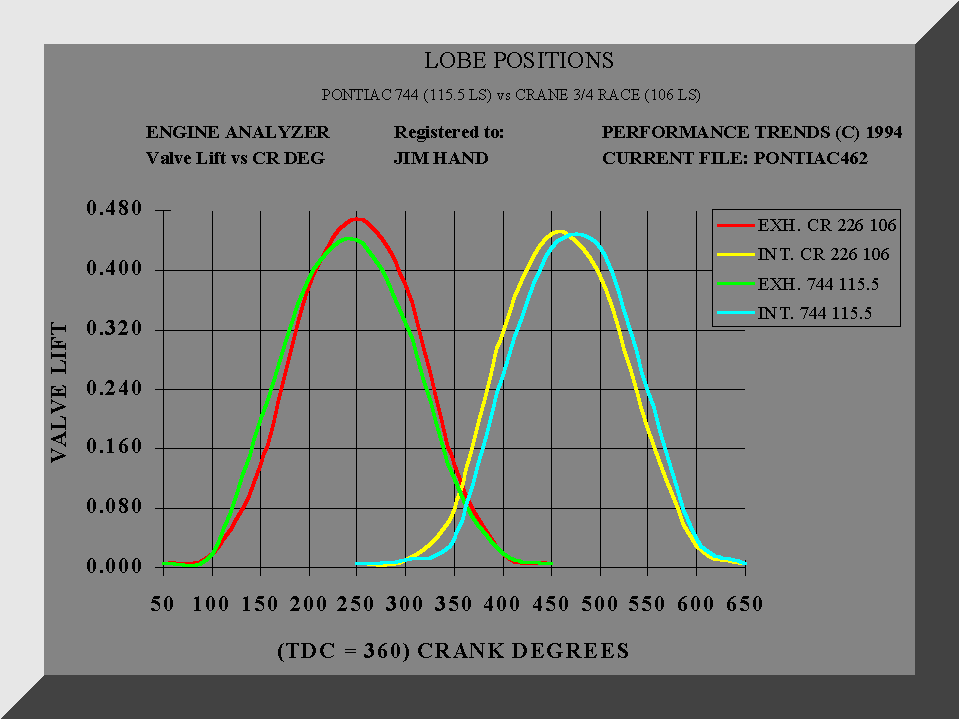
There are somewhat different interpretations among cam makers about the effect of lobe separation.
EFFECT OF LOBE SEPARATION
Crane states the following: " Lobe separation determines where peak torque will occur within the engine's power range. Tight lobe separations (such as 106) cause the peak torque to build early in basic RPM range of the cam. The torque will be concentrated, build quickly, and peak out. Broader lobe separations (such as 112) allows the torque to be spread over a broader portion of the basic RPM range and shows better power through the upper RPM." That is exactly what the computer predicted with the two cams.
Competition Cams states in their catalog: "In general, a wider separation angle results in a "peakier" torque curve more suited to stick shift cars with multiple gear ratios to choose from. Tighter lobe separation angles result in a broader, flatter torque curve that is more suited to automatic transmission cars with fewer gears from which to choose. Therefore, the engines have to be more powerful over a broader range "
So who are we to believe?
My "on car" testing agrees exactly with Crane's
position that tight lobe cams will peak earlier and have a shorter RPM
operating range. The "Performance Trend's" programs certainly agree with
the Crane statement.
SLIDE #7

Another computer prediction ( SLIDE #7 above ) on much longer duration cams shows the same power peaking effect of tighter lobe separation. A Lunati 245-255 with 110 separation and a Wolverine 244-254 with 116 separation, is shown on this slide. Note that the tighter cam has a narrower range, but as the duration is quite long, the power range is still more than adequate for shift points of 5800 to 6000. However, if we wanted to run a very long oval track at a relatively narrow range of RPM around 6000, the 116 cam might be the better choice.
So do we want a tight lobe cam or a wide lobe cam? Pontiac, along with all other original builders, used a wide lobe cam because it provides the best combination of idle, emissions control, gas mileage, and a broad and usable power range. The broad power range is extremely important when we discuss high torque engines, such as the 421 through the 455. These engines provide extremely strong low RPM torque due to their relatively long strokes. Tighter lobe separation tends to concentrate the torque at lower RPM, and may add to a traction problem. We do need to keep the power level high up to the relatively safe shift point of 5000 - 5600. Wider lobe cams do just that. The 350 and 400 engines may benefit from more low end torque, and respond well to tighter lobes. However, be careful that you do not cut off the upper end and lose that benefit of the higher RPM capability of the smaller engines.
We should select the duration and lobe separation
to compliment the RPM at which we actually load the engine. Tight cams
(108 or less) have very serious idle problems with duration of 220 or greater.
A tight, long duration cam works great in a race engine because it is never
loaded at any speed below 1500.
Back to the first slide (
SLIDE #1) one more time. Note that the HP
of the 106 cam peaked at about 4500. Using the general rule of shifting
at 10% above the HP peak, what would the ideal shift point be? (5000).
How about the 744? It appears to peak at 5000. (5500) However, the torque
drops so quickly on the 106 cam that it would be a struggle to get to 5000.
For optimum performance after we leave the line, we want the best spread
of power at the RPM we actually run. For example, I shift my wagon at 5500,
and the RPM drops to just below 4000 in both 2nd and 3rd. Looking at this
slide, which cam would work best? The 744 is clearly much stronger in both
torque and HP in the 4000 to 5500 range. Depending on traction, gearing,
and converter operation, the 106 cam would kick the wagon off the line
harder, but there is no doubt that the 744 would provide a better ET, and
higher speed.
SLIDE #8

A third and last example of lobe separation. Our
test of an 041 with a 230 intake at 112 and separation of 113.5, ground
1.5 degrees advance, against a cam with 232 intake at 104 and separation
of 110 ground with 8 degrees advance, with both having similar lift, illustrates
this subject very well. Here is the computer prediction of these two cams.
The 232 cam shows considerably more torque but less HP than the 041. I
shifted at 5500 and dropped to 3900. The 041 shows more total power in
that range. However, at lower RPM, the 032 has more torque, and it did
produce quicker 60' times. The tighter lobe and advanced cam provided slightly
quicker 60' times, equal 1/4 mile ET, but lost 2 MPH. It also idled
rougher with less vacuum.
SLIDE #9
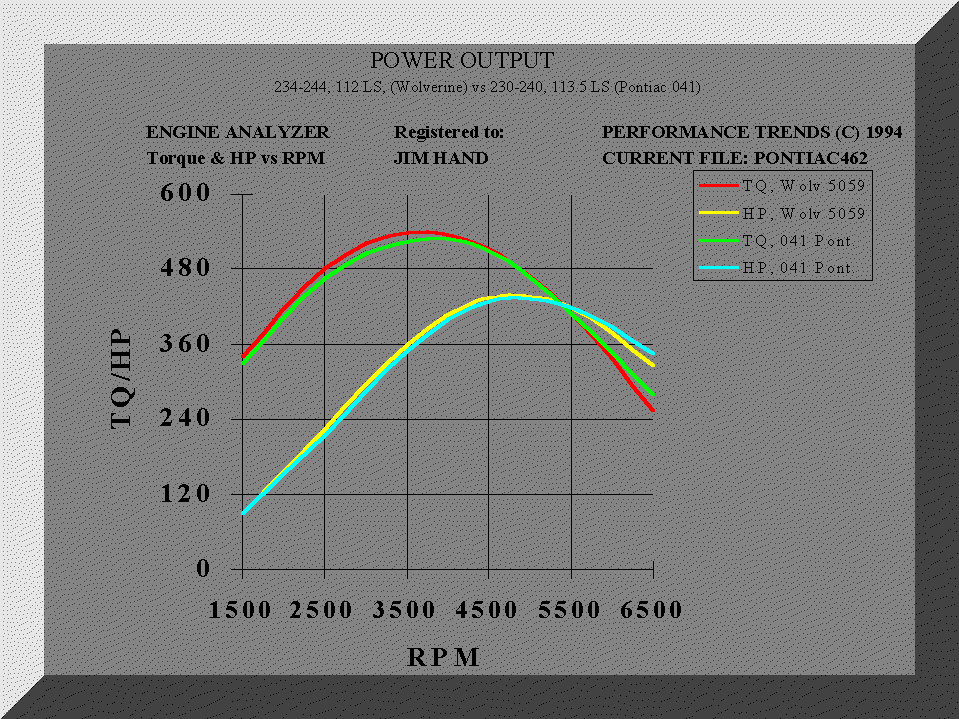
I am now running a Wolverine 5059 with 234 intake
at 107, 244 exhaust at 117, with a separation of 112. It has .325 and .340
lobe lift for approximately .5-.52 lift, depending on actual RA ratio.
Here is the computer prediction as compared to the 041. Notice it has slightly
more torque and HP to 5000. Since I shift at 5500, more power is gained
in the low end of the RPM range then is lost at the upper end of the RPM
range. The result is slightly better ET and speed.
SLIDE #10

What if we could combine the low end of an advanced cam with the upper end power of a wider lobe cam? Here is a prediction of the Wolverine 5059 with Rhoads variable lifters and the 5059 with conventional lifters. Rhoads fast leakdown lifters shorten the duration and reduces the lift at low RPM. They also advance the intake lobe. All three parameters improve low RPM power. With Rhoads lifters, the valves open at the same time, but the spring pressure causes the lifters to leakdown quickly at low RPM. The valve will never lift as high, and will set down earlier. Rhoads claims a 10 degree reduction in duration, and a 10% reduction of lift, at low RPM. At higher engine speeds, less time is available to leak, and this effect is minimized. At about 3500, depending on spring pressures, lobe design, and oil viscosity, they begin to operate similar to standard lifters. Their characteristic clicking is caused by the earlier closing prior to the smoothing effect of the cam closing ramps. The plot shown reflects the maximum leakage for Rhoads, and the other reflects leakage of standard lifters. Obviously, neither plot is totally accurate, but it does show why the quick leakdown lifters, help the low end power. Should you use Rhoads lifters? If your cam is less than 225 degrees intake, you probably don't need them. If it is 230 or over and you are running an automatic, Rhoads lifters will definitely make your car easier to drive, idle better, and run quicker at the strip (providing you do not have serious traction problems).
* If we run nitrous, what grind of cam do we need?
We certainly don't need more low end power. Therefore, a wider lobe cam
will spread the power and minimize early wheel spin problems, and produce
maximum power throughout the entire usable RPM range. How about duration?
As nitrous provides copious amounts of oxygen, we can actually use less
intake duration (if adequate RPM range is maintained). This will provide
better performance without the gas. However, as much additional exhaust
gas is generated, a wider duration exhaust lobe is always needed. The typical
744 and 041 Pontiac cams will work very well with nitrous. I would not
want a typical aftermarket 226 - 226 on a 108 or 110 separation for nitrous
use.
GENERAL RULES FOR CAM SELECTION
Use a fairly
tight lobe separation cam and shift at lower RPM with a heavy vehicle running
a high (2 series) rear axle.
If you want a
wide RPM range with a decent idle, use a wider lobe separation cam.
Disregarding
the adverse effect on idle quality and off idle power, a wider duration
cam with it's higher RPM range allows you to run tighter lobe separation
cams.
Always try different maximum shift points at the strip to find which produces the best ET with your combination. Tighter lobe cams will generally provide better ETs if shifted earlier, in comparison to wider lobe cams.
Both the duration and lobe separation should match the RPM range you plan to load the engine.
True leakdown lifters (such as Rhoads) extends the power range down to a lower RPM, and allows a higher RPM cam to be used in a driveable vehicle.
If running nitrous, use wider lobe separation cams having additional 10 degrees or more exhaust duration than intake duration.
With radical duration race cams (260+), lobe separation may have to be widened due to the negative effects of increased overlap.
Cams/ported heads.
Do we need a bigger cam with ported heads? Maybe. In theory, if we improve flow through the head ports, we can use less duration to obtain equivalent maximum power, and gain even more bottom end power. Unfortunately, in most cases, in order to realize much gain from ported heads, we have to run the engine to a higher RPM. If the present cam does not have the correct lobe positions and duration to accommodate extended RPM ranges, obviously a cam change is required. As previously noted, the intake and exhaust systems must also be able to support the higher RPM, or a cam change and modified heads will not provide the expected performance increase. If you want to run the approximate same RPM with ported heads, assure that the porting helps low and mid lift flow without substantially increasing the port size, or little performance gain will be noted. High lift flow determines peak HP and the associated peaking RPM. Max airflow increase only probably will not help the performance of a moderate RPM engine.
That concludes this presentation.